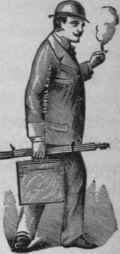Lesson U. Bromo-Gelatin Emulsion Work
Description
This section is from the book "Photographics: A Series Of Lessons", by Edward L. Wilson. Also available from Amazon: Wilson's Photographics: A Series Of Lessons/a>.
Lesson U. Bromo-Gelatin Emulsion Work
325. It has long been the hope of the photographer, and the ambition of the photo - inventor, to secure some means of producing photographic negatives without the aid of the nitrate - bath, which would not only end the miseries that attend upon bath or "wet" work, but which would also secure greater rapidity of exposure. Many, many processes have been offered with more or less success in producing fair results, but the great process desired was not among them. It would be out of place here to go into even a brief history of the matter. Suffice it to say, that in the process now well and favorably known as the Gelatino - Bromide or Bromo-Golatin Emulsion process is found the one that up to date comes nearest to what is wanted. It is now most extensively used in Europe, and at the- time of the publication of this work is becoming largely employed in America. Our photographers, however, are not yet enough advanced in its practice to give us much literature on the subject, and therefore free use is made of what kind friends abroad have published, with the hope that the fraternity here will follow suit when they become more skilled, which indeed they have already begun to do.
326. Thus far the new process has been more extensively applied to out-door work than to portraiture, and the two drawings annexed speak thus materially lost. But what I object to in portrait lenses much more than their price, is the nature of the definition they give, even at their best. There is always that painful obtrusion of the optical plane where the exact focus is determined. Everything before and behind this plane runs so rapidly into " fuzziness " that the exactness of the definition where the image is sharp makes the absence of it the more obvious. We have for years been crying out for what opticians say is a practical impossibility - " depth of focus." The attempt to obtain a "distributed focus " by the patent means of partially unscrewing the back lens instead of giving increased "depth," only ends by producing general "muzziness."
826. Among the many advantages of gelatin plates over wet collodion, such as their being always ready for use, their capacity of waiting for exposure in the camera without risk of spoiling, their ability of securing an image in dimly - lighted places by an indefinitely-prolonged exposure, the convenience of postponing the development, the capability of correct-ing over- and under - exposure by the management of the developer, to say nothing of the crowning glory, their extreme rapidity; in addition to all these advantages there is one other that is by no means so obvious; this will, I trust, in due time be recognized, namely, the means these plates supply of avoiding the known defects of portrait lenses. Hitherto, in our anxious desire for rapid working, we have been obliged to tax the opticians skill to the ex-tremest extent to make up for our deficiency in chemical power. Hence lenses have been made of such large diameter, and of such short focus, that they can rarely be satisfactorily employed except by the free use of diaphragms. The advantage of the costly instrument is
(261 ) more for the advantages of it in the former line than anything else that can be said. In the one we see the landscape photographer of the " wet" persuasion starting out, staff in hand, his apparatus laden upon his bended back, for a day's pleasure.(?) In the other is the advocate of emulsion pursuing the same errand, but with his apparatus complete carried in one hand, with plates sufficient for a day's work. The other advantages besides portability are, that the plates for use with the emulsion processes may be prepared in. the studio, and after exposure they may be boxed and developed at any convenient season - months hence, if necessary. Again, greater rapidity is secured by their use - even instantaneity - while the results are fully equal to those by the " wet" process. With these advantages remembered, then, let the process be considered.
Fig. 74.

Fig. 75.

The weakness of the portrait lens is never so much seen as in the attempt to take large heads. This was particularly shown a few years since at the photographic exhibition, when prizes were offered for the production of life-size heads taken direct. The portraits then shown displayed clearly not only what could not be done, but also what should not be attempted; and, fortunately, we have seen none of these enormities since. Yet, so long as we needed take babies, nervous people, dogs, and other animals (and these often in an indifferent light), we have been compelled to use these optically and artistically - imperfect instruments because our plates were not otherwise sensitive enough. I remember some twenty years since, when Dallmeyer brought out his triplet lenses, using them for portraiture. I was charmed with the exquisite nature of the image; nothing was severely sharp, and nothing was out of focus. The optical plane was there, but the gradual approach to it and the gentle retiring from it was so insensible that the definition was perfectly delightful compared to that of the usual portrait lens. But the slowness of the instruments compelled me to abandon them for studio work. Now, however, all is changed, and the rapidity of our plates will
327. As it is the policy of this work to give honor to whom honor is due, be it known then that the skeleton of the method which follows is largely made up from the best paper yet published on the subject, which was recently presented to the French Photographic Society in Paris by
Mons.M.Bascher, while the notes come largely from contributors to the British Journal ofPhotography. Thus full
Instructions are given in every branch of the process in all details.
Doubtless the novice will find it most economical it first to make pur-ehaas of his plates, or at least the sensitive pellicle with which to make the emulsion, already prepared, as plentifully offered in the market of excellent quality by number of American manufactures, since the manufacture of them is attended by so many difficulties and drawbacks.
Were nothing else in the way, that, mule of all ingredients, gelatin, must be handled, and it requires knowledge and patience. Get acquainted permit us to use in good light, and on reasonably - quiet sitters, this superior class of lens. I therefore strongly counsel professional photographers in good light to use for their cabinet, promenade, panel, or similar portraits the rapid rectilinear or the symmetrical lenses; and to keep in reserve, to be used only on special occasions, the more imperfect though quicker-working portrait lenses. It is not sufficient to say that by using smaller diaphragms the portrait lens can have its objectionable character removed. I think not; the image is certainly improved, but it is apt to be too sharp in one plane, and not to possess that general artistic distribution of definition the other lenses give. I also think that the large glasses of the portrait lenses furnish greater risk of admitting diffused light in the camera - flattening and degrading the image on gelatin plates - than the smaller lenses. - Jabkz Hughes.
827. It has been established by Captain Abney and others that gelatino-bromide of silver emulsion gains in sensitiveness by keeping. It has not, however, been sufficiently taken into consideration what a very important factor in the result is temperature.
First It may be laid down as one of the canons of gelatino-bromide of silver emulsion manufacture that the sensitiveness (times being equal) is directly as the temperature at which the emulsion is kept. A t 40° F. it will be less sensitive than an emulsion kept at 80° F. The cause is not far to seek. At the low temperature, the sensitive particles are held tightly by the medium which prevents their free motion. As the temperature rises a loosening takes place, which, permitting freer motion, allows scope for chemical or molecular changes.
Second. This question of temperature has another important aspect. It has a material influence on the gelatinizing property of the gelatin. A second canon is this: The gelatinizing quality is permanently affected inversely as the temperature at which the gelatin is kept. The higher the temperature, the lower the gelatinizing quality induced permanently. Gelathe kept in a fluid state at a high temperature passes into the condition known as meta-gela-tin. which has no setting property. Possibly pure meta-gelatin is favorable to sensitiveness, as allowing the particles of stiver bromide freer play. But meta-gelatin is soluble in cold water, and probably could not be used by itself for emulsion work, as it would wash away under the developer. If it could begot into collodion, it might solve the problem of rendering with it in harness first. Once having mastered the matter of exposure, and especially of development, it will not be hard to do more.
Continue to:


